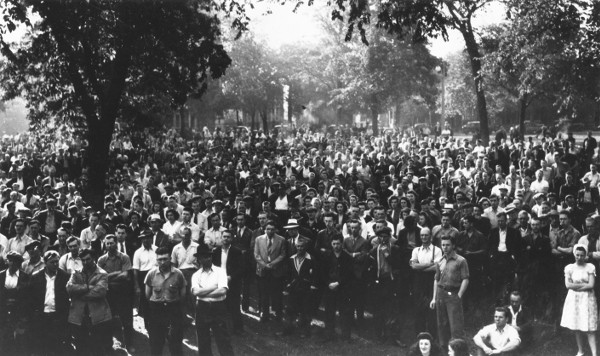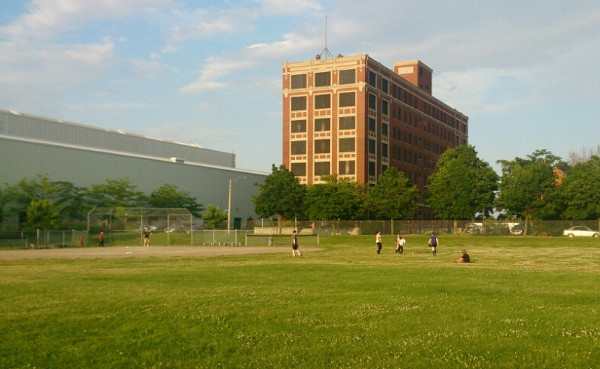Two very different planning process went on in Hamilton during the 1950s: nature was protected in West Hamilton while being systematically destroyed in Central and East Hamilton.
By John Bacher
Published March 29, 2018
In response to my recent essay on rioting in Hamilton as a negative response to nature deficit disorder, I received a private response advising me about two positive greening projects in central Hamilton that are worth considering in more detail.
These involved two paper projects - the Gage Park Master Plan and stormwater management on Ottawa street - which have not yet been realized. Understanding this situation points to the reality that those in power have created a situation where east end and central Hamilton are trapped in a nature deficit.
Hamilton's nature deficit disorder is based on similar elements of class oppression that have been recognized by urban geographers and historians around the world.
The term "east end", describes a ghetto for those with limited financial means. They essentially cannot afford to live in the luxury of having wildlife friends, such as singing blue jays and colourful Hummingbirds around them.
This is a reality shaped by prevailing winds that disperse industrial pollutants to the east.
And it continues to this day. A terrible scheme seeking to make Hamilton the garbage-building capital of the Great Lakes was only stopped on July 22, 2017.
The slowness of paper greening schemes to come to reality in central and east Hamilton is expressive of harsh reality, shaped by narrow class oppression myopia and political corruption. Nature deficit is caused by what political scientists who value social solidarity call democratic deficit. The way out of it is to get more people involved in the democratic political process.
In this regards, Hamilton can learn much from past heroes, such as a former Mayor Same Lawrence, his close friends and park advocate, Thomas McQuesten, and a sadly obscure artist, Murray Thomson.
One paper project that shows the crawling pace of change is the Hamilton's long-term plan for Gage Park. It was approved in 2010 after five years of consultations. Eight years later, nothing has come out of the more innovative aspects of this plan, which would help in restoring vanished natural diversity.
The Gage Park Master plan calls for bio-swales in the park's parking lot. Good idea, but where are they eight years later?
Another fine aspect of the Gage Park master plan is "introducing maintained meadow" as part of "a reduced lawn care program." Where are such naturalized meadows today?
The Gage Park Master plan apart from has a protection on cheap approach towards the Niagara Escarpment. It properly prevents the construction of any buildings Gage Park that would block vistas of the Escarpment. At a time of strained park budgets, however, such risks are remote.
The plan ignores pricy measures such as building an eco-passage bridge that would actually allow rabbits and hikers to connect to Gage Park without the fear of being hit by a train or truck.
Another paper project which has yet to be realized is an award winning design for bio-swales on Ottawa Street North around Argyle and Edinburgh streets. This green blessing is essentially a much-needed windfall from the corporate philanthropy of the pharmaceutical retailer, Rexall. It has plans for a new outlet here.
The rezonings needed for the Rexall development were approved three years ago.
To understand what can be done beyond the slow-moving paper promises, it is helpful to go to a time which the great Canadian philosopher, George Grant, who spent his most productive thinking time in Hamilton, termed the "Utopian Days."
During these Utopian days, the great Stelco strike of 1946 laid the basis for collective bargaining in Canada. It was a time when there was no democratic defecit - mobilization in political struggle was at its peak.
Sam Lawrence was Hamilton's Mayor during the Utopian Days. Lawrence was part of a CCF slate that controlled City Council. He refused to call upon the army to break the Stelco strike, saying he was a labour man first, chief magistrate second.
At the same time, Thomas McQuesten served on the boards of the Hamilton Parks Commission and Royal Botanical Gardens (RBG) board. This was also the most creative time for the Hamilton artist, Murray Thomson, who was a Westinghouse production worker. He also organized an artists' union.
Thomson was the product of the greatest cultural hubs of Hamilton, Woodlands Park. Dubbed "The People's Park", its giant shady tress were once part of an old growth forest called Land's Bush.

Union workers assembling at Woodlands Park (Image Credit: Workers' City)
Located next to the Westinghouse factory, the six acre park was a venue for political discussions and protests. Some of the demonstrations there were frequently broken up by firemen and police in violation of Democratic norms. This "People's Park" was the start of a 10,000 march to Stelco at the peak of the 1946 strike.
What most distinguished the strike of 1946 was the artistic flair of the marchers who gathered in Woodlands Park. The marchers were led by Thomson, disguised in a masked effigy of the reactionary Conservative party politician, Nora Francis Henderson. Other masked marchers were linked arm and arm as the Prime Minister, Mackenzie King, and a notorious capitalist called "Old Iron Jaw Hilton."
While union rights triumphed in 1946 and as Thomson banner's proclaimed labour did "knock out" their political foes, changes after 1946 were negative for central and east end Hamilton. This was during a time when McQuesten had died and Lawrence began a slow retirement from politics.
It was a downhill time for Hamilton's Centre and east end. No new nature parks blessed the city. Instead, homes were bulldozed for an asphalt sea of parking lots, many of which were subsidized by massive "urban renewal" schemes paid for by the federal government.
The efforts to try to turn much of Hamilton into a giant slum was vividly witnessed by the demise of Woodlands Park as a cultural hub. This was accomplished through the uprooting of its majestic trees. Its the landscape was converted to treeless aesthetic fields which still dominate the park. According to labour activists such as Bert McClure, this mutilation was done to prevent large-scale gatherings from being held there.

Woodlands Park with Westinghouse building in background (Image Credit: Jason Nason)
When plans emerged that would eventually multi late King's Forest Park for the Red Hill Creek expressway in the 1950s there was a very different approach taken in West end Hamilton moreover. This west end extended into the entire Halton region and to much of the adjacent lakeshore landscape of Peel.
I got a sense of the basic divisions between the West end and East end of Hamilton, when walking with Don McLean and other foes of the Red Hill Creek expressway to Toronto.
When we got to the Burlington side of the beach, we met an affluent businessman from this community. He told us why he supported the Red Hill Creek expressway but opposed the Mid-Peninsula Expressway in his home town.
Essentially, he wanted pollution to stay in the east end, away from his friends, employees and family. Fumes from east end Hamilton for the Red Hill Creek expressway would be blown away by the prevailing winds and not choke his loved ones.
Two very different planning process went on in Hamilton during the 1950s. Downtown Hamilton became marred by one-way street expressways. This doomed an attempt at a small enclave of civility, Hess Village.
Victorian Hamilton neighbourhoods based on transit were pulverized by the demands of the automobile. New industrial areas in the east end around Stoney Creek had no aesthetic embellishments, such as trees or ponds.
Similarly, it is not surprising that the air of the east end would be toxified by the ill-fated but mercifully short-lived SWARU municipal garbage incinerator. The fumes it belched out made Hamilton's steel mills look like green wonders of design.
To this day, the Hamilton Port Authority continues its mad incineration mania, seeking to have garbage from throughout the Great Lakes region shipped in by lake freighters.
An entirely different approach took place in the west end Hamilton, Burlington, and Oakville. Here there was a determination that even oil refineries should be built in a way that was in harmony with nature. This succeeded to a remarkable degree. The oil refineries were built with careful buffers, including complete forests, some of which provided a refuge for the endangered Red Headed Woodpeckers.
Halton Region and Peel along the lakeshore may be the only area in the world where the homes of the one percent are adjacent to oil refineries. Here the grounds of petroleum refineries are also refuges for deer and rare woodpeckers. There is no nature deficit in Halton Region, despair its plethora of heavy industry. This green pattern is clear all along the Lake Ontario lakeshore, with massive forests lining oil refineries as far as Port Credit.
Efforts to wipe out the legacy of the green planning in the west have led to protests and political organizing. This has resulted in municipal councils being controlled by the Green Party of Canada, through its regional affiliate, Halton Greens.
A critical aspect of its organizing was a campaign against the development for residential purposes of a former oil refinery buffer in Oakville on Lake Ontario, Shell Park. This political mobilization to defend the green legacy of the good planning of the past ended the democratic deficit that had allowed paving interests to dominate municipal councils in Halton.
Think tanks such as the Hamilton Institute are right to criticize art crawls which are disconnected from the broader landscapes. Art crawls through ugliness don't make sense.
The Pollution Crawl that helped stop schemes for making Hamilton the garbage-burning capital of the Great Lakes is helpful in showing how crawls can seek to restore beauty to our landscape. Sherman Inlet in Hamilton Harbour was to have been the site for a garbage-burning facility.
It is to be hoped that its resoration will be on a bigger scale than anticipated and that more of the buried river will be exposed and brought back to life.
Cleaning up the polluted legacy of the past is difficult for Hamilton to finance, with the decades-long struggle to clean up Randall's Reef being a vivid example. Past Pollution Crawls can be morphed into restoration crawls, on the scale of the artistic marches that were launched from Woodlands Park in 1946.
By KevinLove (registered) | Posted March 29, 2018 at 15:23:49
To be fair, it is not just Gage Park that the City is slow to invest in. Even here in the mansion district, the recent revitalization of Durand Park took approximately forever to move from paper plans to action. And we STILL do not have properly paved park paths.
By GWW (registered) | Posted March 31, 2018 at 08:57:12
What natural areas were destroyed in the 1950's in the east end? (There may have been farmland, that was developed for housing, but I don't consider that natural) The central part of the city? Or what areas were designated to be saved in the west end of the city? When you start talking about "Nature deficit disorder", all credibility goes out the window. The green space of the escarpment crosses the entire city and is accessible to all when I was a kid. When your older even more green space is accessible, if desired.
You must be logged in to comment.
There are no upcoming events right now.
Why not post one?